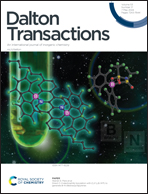Phosphonate-substituted porphyrins as efficient, cost-effective and reusable photocatalysts†
Abstract
Recent advances in visible light photocatalysis represent a significant stride towards sustainable catalytic chemistry. However, its successful implementation in fine chemical production remains challenging and requires careful optimization of available photocatalysts. Our work aims to structurally modify bioinspired porphyrin catalysts, addressing issues related to their laborious synthesis and low solubility, with the goal of increasing their efficiency and developing reusable catalytic systems. We have demonstrated the catalytic potential of readily available meso-tetrakis[4-(diethoxyphosphoryl)phenyl]porphyrins (M(TPPP)). Novel metal (Pd(II), Co(II) and In(III)) complexes with this ligand were prepared in good yields. These chromophores were characterized in solution using spectroscopic (NMR, UV–vis, fluorescence) and electrochemical methods. The introduction of phosphonate groups on the phenyl substituents of meso-tetraphenylporphyrins (M(TPP)) improves solubility in polar organic solvents without significantly altering the photophysical properties and photostability of complexes. This structural modification also leads to easier reductions and harder oxidations of the macrocycle for all investigated complexes compared to the corresponding TPP derivatives. The free base porphyrin, zinc(II), palladium(II), and indium(III) complexes were studied as photocatalysts for oxidation of sulfides to sulfoxides using molecular oxygen as a terminal oxidant. Both dialkyl and alkyl aryl sulfides were quantitatively transformed into sulfoxides under blue LED irradiation in the acetonitrile–water mixture (10 : 1 v/v) with a low loading (0.005–0.05 mol%) of porphyrin photocatalysts, where H2(TPPP) and Pd(TPPP) were found to be the most efficient. The reaction mechanism was studied using photoluminescence and EPR spectroscopies. Then, to access reusable catalysts, water-soluble derivatives bearing phosphonic acid groups, H2(TPPP-A) and Pd(TPPP-A), were prepared in high yields. These compounds were characterized using spectroscopic methods. Single-crystal X-ray diffraction analysis of Pd(TPPP-A) reveals that the complex forms a 3D hydrogen-bonded organic framework (HOF) in the solid state. Both H2(TPPP-A) and Pd(TPPP-A) were found to catalyze the photooxidation of sulfides by molecular oxygen in the acetonitrile–water mixture (1 : 1 v/v), while only Pd(TPPP-A) resulted in selective production of sulfoxides. The complex Pd(TPPP-A) was easily recovered through extraction in the aqueous phase and successfully reused in five consecutive cycles of the sulfoxidation reaction.



 Please wait while we load your content...
Please wait while we load your content...